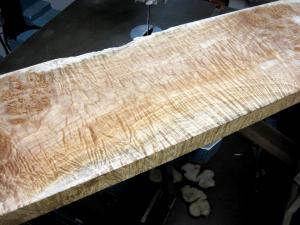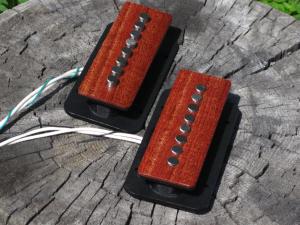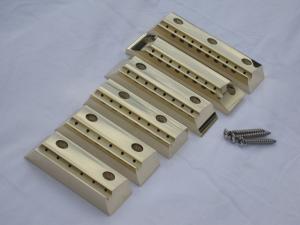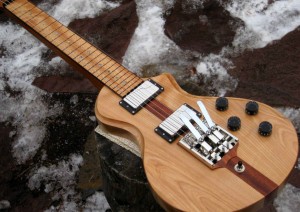Sometimes it’s amazing what you can find in your own backyard. For years, friends of mine have been telling me I need to meet Ryan Rukavina who is a luthier here in my home town of Missoula, Montana. We finally met in person a few weeks ago when he did some work on my Travis Bean guitar. I was literally blown away with what I saw in his shop. Mr. Ryan Rukavina of Rukavina Guitars is doing some fantastic work with guitars and his creative and experienced eye/skill with wood is clearly evident in his pieces.
After seeing his work, I have to talk about it on EffectsBay.com. Ryan builds guitars but also builds lapsteels and ukeleles. Additionally he machines brass bridges and winds his own pickups with wood faces. The items that stood out for me while visiting him was the quality of workmanship on all aspects of the build, and his eye and choices when it comes to the woods he used. I’m a fan of natural finish guitars and he takes that to the next level.
If you’re looking to have something custom, I think you should give Rukavina Guitars a good look! I was able to send some questions to Ryan about what he’s doing and he was kind of enough to answer them in detail.
– What got you into building guitars?
I suppose it sort of started with failure. I attempted college immediately after high school at MSU (Montana State University), and signed up to study mechanical engineering, knowing that ultimately I wanted to be involved in making things. The college education proved not to be my my cup of tea(irrelevant required classes, high cost, lack of specific dedication to a given subject for more than an hour and a half in the class, etc, etc.)…it seemed inefficient, and I felt out of place & without specific direction. I had taken up guitar around age 13 because my mom had noticed an interest that I had in an old Sears archtop that she kept from her youth. After hearing me pluck out two string melodies enough times, she and my dad got me lessons for either a Christmas or birthday gift, and my obsession with the instrument began. So, at the time of bowing out of the college experience I had been playing guitar for 6 years or so. I believe I had changed out a pickup & a jack, and did a poor refinishing job on my Strat copy Epiphone, but any notion of guitars being something I’d like to pursue making didn’t click with me as an option. One day while waiting for the semester to end and pondering what the hell I would do with my life now, I saw a television program where a man was repairing a violin, and talking about the craft…it wasn’t a guitar, but for one reason or another this otherwise meaningless moment is what planted the seed of pursuing guitar making as a possibilty. I believe someone else in the room who knew that I played guitar and was quitting school piped up and said, “that’s what you should be doing!”
The next year was spent regrouping in my parent’s basement & working at Mama Cassie’s restaurant back in my hometown(Great Falls, MT), and searching for all available schools or apprenticeships that taught guitar construction. I was particularly interested in electrics, probably from licking too many 9 volts as a kid. Most of the schools offered only acoustic construction and repair. Roberto-Venn School of Luthiery, however, was one of the schools I’d found advertising in the back of a Guitar World magazine who offered equal instruction on electric guitar construction and repair, so I called for a brochure. I happen to be one of the lucky ones who has parents that are supportive and didn’t want to rain on my pipe dream. So my dad agreed to fly down to Phoenix with me to visit the school for ourselves. We went. The school met and exceeded my visions of the kind of creative environment I wanted to be in, and I was staggered by the variety and quality of workbeing done in the class I visited. Students were inlaying whatever they wanted into woods I’d never even seen before, on guitar shapes they designed themselves… The instructors were making unbelievable harp guitars, resonators, electric mandolins, etc. If you drove by the place you may not look twice, but as far as I was concerned the activity inside was enchanting. The school accepted me for the winter class of ’96, and that’s how I got going. That was 15 years ago, and it’s since taken me years to accumulate the tools, the designs, and the confidence to be where I’m at. I worked mostly as a baker in that time after school, a skill I got into back at Mama Cassie’s. It was about 5 years ago that I got fed up with baking primarily, with guitar work as a secondary thing. Now guitar work is all I am dedicated to…it is the life of a struggling artist living hand to mouth at times, buying strings and tuning machines instead of food, but I’m obsessed with my work(much like a musician).
– How did you get into wood working in general?
I was a 4-H-er as a kid and did a few woodworking projects for the State Fair; lamp, birdhouse, that kind of thing, and I took woodshop in middle school. I also built more bike ramps than you could shake a bloody knuckle at as a teenager. Beyond that, my experience for the detail woodworking required for guitar work was minimal when I went to Roberto-Venn. The joinery skills, tool technique, and jig making used in guitar work was taught at school. They recommended some basic woodworking at the time I enrolled, but it was not required. I’d have to say that my skills in the guitar making area have actually translated over to other woodworking skill sets(box making, antique restoration, small furniture, carving).
– What are your factors when picking out woods for the guitar?
If the wood species are pre-chosen by the customer’s preference or a specific design, and I am following their lead, I single out the cuts that aesthetically fit the bill and then do a couple rule-of-thumb tests to the piece of wood to see how well it resonates.
 –the knuckle test— knock on the cut with your knuckle and listen for some level of ‘tink’ in the sound, and steer clear of a ‘thump’ or more thuddy type of tone when you knock on it..
–the tuning fork test– I have an A tuning fork, not sure which A it is, but it’s high pitched, and I have larger E tuning fork that is lower pitched. I’ll strike them and hold them to the wood to hear if there is reasonable volume and resonance with both. It is not scientific by any means, but more of an educated guessing game. If I am making something from imagination I’ll choose woods I already know I have liked the tonality of in the past. Aesthetically I am usually looking for a strong contrast of woods in my guitars. With some woods weight is a factor that I must consider as well. Fingerboards must be hard and relatively consistent on standard guitars for good sustain qualities. As some of my lapsteel builds show, however, I can use knotted or unusual cuts on them because there is no tone transfer at the fingerboard surface since the steel bar, and not the frets/fingerboard, is making the contact with the strings. It is certainly not scientific, and you never really know what you’re going to get 100%. In electric guitars wood choice is an important tonal consideration, but as Danelectros and other non-tonewood guitars can prove, they sound just as fantastic through in their own particle board right. Pickups, strings, and amp are all just as critical aspects of the overall tone as the wood is with electric guitars. That’s beauty of electric guitars.. there are so many factors that go into a ‘tone’ that it can be adjusted…plug the same guitar into 3 different amps/pedals and you may get 3 distinct results. Change the strings and swap a capacitor or pot out, and get another 3 results…swap pickups, and there you go again… I deeply admire a good acoustic builder for not having this flexibility, and using only his/her experience and knowledge of the physical resonance of the wood to produce a given sound.
– Name some of the exotic woods you use.
Off the top of my head, I have used wenge, cocobolo, bubinga, rosewood, purpleheart, swamp kauri, and ebony…I suppose those are considered exotics. Curly koa is one of my favorites, but it may be considered a figured domestic? I do have a bit of some of these on hand that I will use up, but I am increasingly more interested in looking for domestics for the bulk of my build material these days(walnut, maples, ash, alder, etc.), and reserving exotic use to veneers, headcaps, fingerboards, and other low bulk uses. Although I am only making enough guitars a year to fill a closet, and not a warehouse, I am becoming more conscious that by purchasing even a tiny board of rainforest wood I am very likely contributing to a problem on another part of the planet. Factoid, when you mill/cut purpleheart it dulls your tools like crazy and smells like rotten troll feet.
– What separates your guitars from other boutique guitar builders?
Probably that my stylistic approach differs a bit. My affinity for more wood, less plastic, and a natural looking finish. I seldom ‘paint’ my instruments. It may be a better question for someone buying one of my instruments…I have been told that I have ‘a good eye’. My carved work seems to get the most hubbub, so likely my sense of curves and three dimensionality distinguishes some of my work…
– What got you into designing some of your other stringed instruments like lap steels and ukeleles?
The lapsteels began after doing my first couple of standard guitars (I call them armpit guitars). I’d always felt more comfortable playing slide guitar on an armpit guitar with the guitar laying down on my lap. After making my first couple armpit guitars I accumulated scraps that weren’t large enough for more armpit parts, so I made a lapsteel or two just to explore them and get rid of some wood. A family friend subsequently sold them on their ebay account for me. My interest was there, customers had an interest, and I was able to produce a lapsteel in substantially less time than an armpit guitar…with less initial cost. I’ve recently been putting more focus back to armpit guitars, but will continue making lapsteels. The ukes I’ve done had more to do with being approached by customers than my digging in independently, but I have a couple tele styled ukes in the works that are of my own gumption, and I’m very interested in continuing making them. I want to be making absurd little Explorers, FlyingVs, and other more extreme guitar shapes into wee ukes…I think there’s an element of novelty and wonder in miniaturizing familiar things. I get a kick out of that for some unknown reason, and ukes are just cool.
– What other items do you offer?
– Pickups
– Bridges
– How much are these components?
I offer bridges, pickups, and nuts designed for lapsteel use, usually posting them to ebay for sale. Ebay brings great exposure, and often encourages folks to contact me regarding custom work.
Bridges and nuts are usually made of brass and often nickel plated, and sometimes made of aluminum. I can usually accommodate if approached to do a custom bridge for a lapsteel, and price is usually discussed per design($70-120 for a custom bridge). Typical cost on ebaying various bridges has been about $60-75 for (6,7, 8, or 10 string), nuts are usually around $25-30, and pickups have been around the $70 mark. I cannot say I have a set price on anything currently because my designs are always evolving, and material and tool costs seem to inch higher every several months, so I usually determine cost upon listing or being asked for a quote.
– Why should I buy yours vs. any other aftermarket pickups or bridge
Lapsteelers want a bridge that is flat(non-radiused), which don’t really get made as aftermarket products, and some folks want as narrow as a 1 7/8″ string spacing, and as wide as a 2.25″ string spacing for a bridge; hard to find, even in radiused armpit guitar bridges. I’ve think I simply filled the void, and that’s likely why most people buy…on the everyone-accessible ebay at least. I have also had a number of repeat customers who simply like the easy to install, no bs, wraparound design of my bridges. I’ve been told they look very nice, too. The pickups I have offered have been typically 8 string single coils, which I began making in the advent of my learning to wind pickups, about 2-3 years ago.  Same kind of thing, no one else was offering 8 string single coils for steel guitar on ebay. Jerry Wallace makes a fine single coil, the True Tone, but it was never offered on ebay for the one-click shopper doing a home build, so I got into winding and tried to fill the gap there at a similar cost. I can’t say that my pickups are any better tonally, just available and wound for a steel guitar voicing at ~$70 shipped…although, I’ve made some sharp looking pickups with exotics and that does add desireablity for some.
– Where do you like to see your business in 5 to 10 years?
Existing, and I’d like to develop some model names and stock dimensions for a couple of my designs, both lapsteel and armpit. I’d also like to get a few of my instruments in the hands of touring pros soon, and move beyond the point of being a work-alone artisan, and possibly put some good folks to work on a very small scale, producing a couple models to have ‘on shelf’. I’d really just like to still be in 5 to 10 years.
– How much do your average electrics cost?
Armpits can range from $1000-2500. $1000 would be bare bones, one pickup, dot inlays, oil finish, etc. Approaching $2000 will get into carving, better hardware, inlay work, etc. And $2500 and up would be in the realm of heavy joinery, binding, nitro finish, etc. Lapsteels start ~$700-800 for bare bones, and similar to armpits can approach $2000 given more finicky options, hardware, etc.
– Do you offer models or are all of your builds custom?
No model names yet. If approached for a custom build or putting something for sale on ebay I simply refer to my typical asymmetrical shaped lapsteel design as ‘small bodied’, and the more typical guitar shaped lapsteels I’ve done recently as ‘large bodied’. I realize this is very lame to someone shopping for a guitar, and I hope to get some models dialed in over the next year.
– What is the average build time if I put in a order?
Build time on the simplest lapsteel can be about 2-3 months at my current work load, and more complex builds have taken 1-2 years to complete, but average build time ballpark is ~6 months.
As you can see Rukavina Guitars is doing some great things. Please check out Rukavina Guitars on the web and like them on Facebook. Both sites are great to see what he’s up to and he posts photos often.








